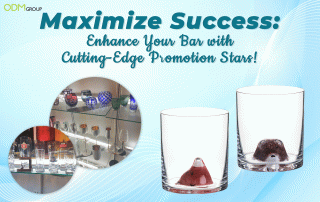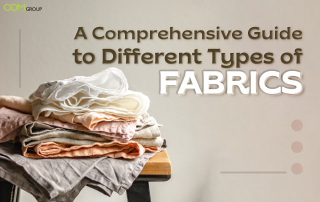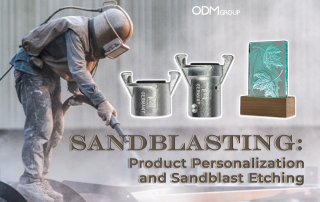From creating stunning glassware for restaurants and hotels to producing precision-engineered glass components for high-tech applications, the world of glass manufacturing plays a vital role in our everyday lives and business operations.
In this blog, we will delve into the glass manufacturing process, focusing on a crucial decision that business owners often face – the choice between handblown and machine-blown glass production. We will also give you some helpful tips on what to consider when choosing a glass manufacturer.
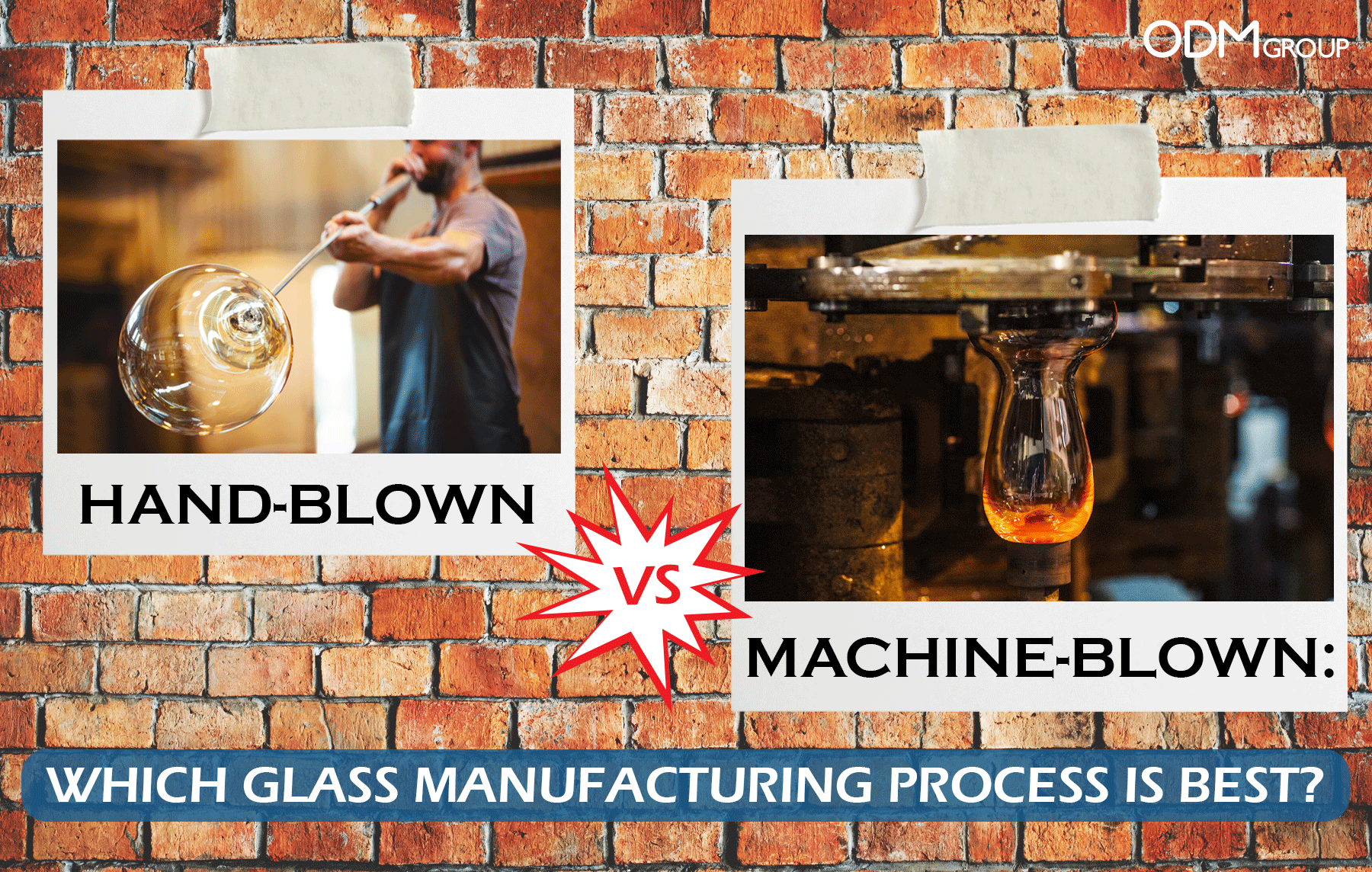
Understanding Glass Manufacturing
Glass manufacturing is a multi-faceted process that transforms raw materials into a wide range of glass products, serving diverse industries worldwide. To appreciate the distinctions between handblown and machine-blown glass production, it’s essential to grasp the fundamental principles of how glass is made.
The Glassmaking Process
At its core, glassmaking involves the transformation of silica, soda ash, and limestone into molten glass through high-temperature fusion. Here are the key stages of the glass manufacturing process:
1. Batch Preparation: The raw materials are meticulously measured, mixed, and blended to create a homogeneous batch. The specific composition of the batch can be customised to meet the requirements of the final product.
2. Melting: The batch is then heated to extremely high temperatures (typically over 1700°C or 3092°F) in a furnace. The intense heat causes the raw materials to melt and form a molten glass mass.
3. Forming: Once the glass reaches a consistent, workable state, it is either hand-shaped by artisans or mechanized through moulds and machinery. This stage is where the distinction between handblown and machine-blown glass production becomes evident.
4. Annealing: To relieve internal stresses and enhance the glass’s structural integrity, it is slowly cooled in a controlled manner. This process minimizes the risk of breakage and ensures product durability.
5. Cutting and Finishing: Depending on the product type, the glass may be cut, engraved, polished, or undergo various finishing processes to meet specific design and quality standards.
Hand-Blown vs. Machine-Blown
Hand- Blown Glass: Pros and Cons
Handblown glass, often referred to as an artisanal craft, embodies a centuries-old tradition that celebrates the artistry and craftsmanship of skilled glassblowers.
The process dates back to around 50 B.C.; it is widely believed that the Phoenicians invented it. It is an ancient art form which was used to make glass jars, vases and glass ornaments. This technique was used from 50 B.C up until the 19th century.
Let’s explore its intricate process, the unique advantages it offers, as well as some of the inherent challenges.
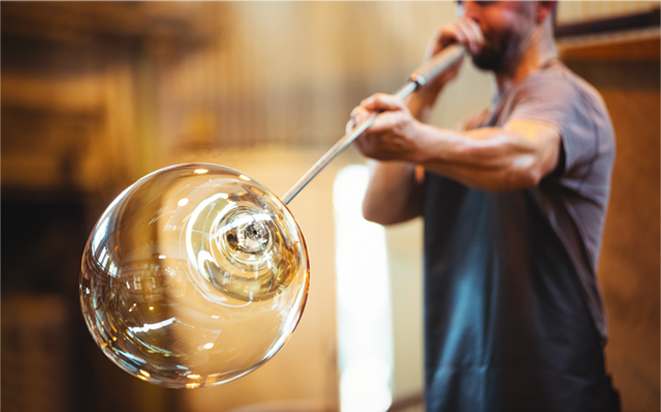
-
The Process
1. Gathering Molten Glass: Handblown glass production begins with gathering molten glass from a furnace using a blowpipe. The glassblower skillfully rotates the pipe, ensuring the glass adheres evenly to the pipe’s end.
2. Shaping and Blowing: The glassblower shapes the glass by blowing air through the pipe, creating a hollow form. The artisan uses various tools, moulds, and their breath to shape the glass into the desired design, be it a vase, goblet, or intricate sculpture.
3. Decorative Techniques: Handblown glass allows for an array of decorative techniques, including marbling, fritting, and the incorporation of coloured glass. Artisans can create unique patterns and textures, making each piece one-of-a-kind.
4. Cooling and Annealing: After the glass takes its final form, it is carefully placed in an annealing oven to cool gradually. This slow cooling process minimizes internal stress and ensures the glass’s longevity.
-
Advantages
1. Artistic Expression: Handblown glass is celebrated for its artistic freedom. Skilled artisans can create intricate, personalized designs that reflect their creativity and expertise, resulting in truly unique pieces.
2. Imperfections as Beauty: Handblown glass often features subtle imperfections that add character and charm. These imperfections, such as tiny bubbles or variations in thickness, are considered part of the art’s beauty.
3. Customisation: For business owners looking to offer bespoke or limited-edition glass products, handblown glass is an ideal choice. Artisans can collaborate with you to bring your specific design concepts to life.
-
Disadvantages
1. Limited Volume: Handblown glass production is inherently slower and labour-intensive, making it challenging to produce large quantities of identical items within short timeframes.
2. Higher Costs: Due to the manual labour and time involved, handblown glass products often come with a higher price tag compared to machine-made alternatives.
3. Minor Variations: While the imperfections in handblown glass are celebrated as part of its charm, they may not always align with the strict uniformity some businesses require.
Machine-Blown Glass: Pros and Cons
Machine-blown glass production represents a modern, highly efficient approach to creating glassware and glass products. Let’s talk about the automated nature of this process, the advantages it offers, and the potential drawbacks associated with machine-blown glass.
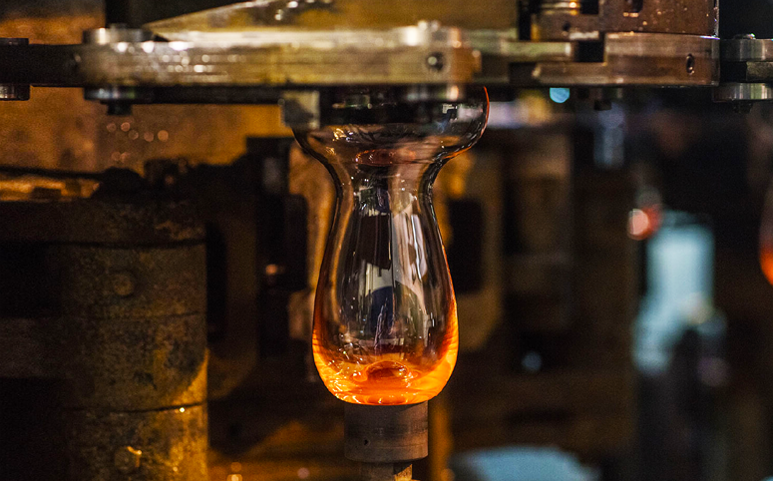
-
The Process
1. Automated Shaping: Machine-blown glass production relies on automated systems, moulds, and machinery to shape and form glass. This process ensures precision and consistency in each product.
2. Mould Usage: Glass is blown into moulds that determine the final shape and design of the glassware. These moulds can be customized for various designs, making it possible to produce a wide range of glass products.
3. High-Speed Production: Machines work quickly, allowing for large volumes of glassware to be manufactured in a relatively short time. This efficiency is a key advantage for businesses that require mass production.
4. Quality Control: Automation enables strict quality control measures, minimizing the likelihood of defects and ensuring uniformity in the final products.
-
Advantages
1. Cost-Efficiency: Machine-blown glass production is generally more cost-effective than handblown methods due to reduced labour costs and higher production volumes.
2. Consistency: Businesses seeking consistency and uniformity in their glass products can rely on machine-blown glass to provide identical pieces, minimizing variations.
3. Scalability: As your business grows, machine-blown glass production is easily scalable to meet increased demand without compromising on quality or consistency.
-
Disadvantages
1. Lack of Artistic Individuality: Machine-blown glass often lacks the artistic uniqueness and individuality that characterizes handblown glass. Each piece tends to be identical, which may not align with businesses that value the handcrafted touch.
2. Limited Customisation: While some customization is possible, machine-blown glass is less flexible in terms of creating unique designs and artistic patterns compared to handblown alternatives.
3. Environmental Concerns: Large-scale machine production can have a higher environmental footprint due to energy consumption and the potential for waste. This may be a consideration for businesses focused on sustainability.
How to Find the Right Glass Manufacturer?
Selecting the right glass manufacturer is a pivotal decision for business owners and company executives. The choice you make can profoundly impact the quality, cost, and overall success of your glass-based products. To help you navigate this critical decision, here are some valuable tips and considerations:
1. Define Your Needs
Clearly define the type of glass products you need and their specific characteristics, including size, shape, and material properties. It is also important to establish the quality standards you expect from your glass manufacturer, considering factors like transparency, strength, and durability.
Furthermore, determine the scale of production you require, whether it’s low-volume, high-volume, or something in between.
2. Research Potential Manufacturers
Look for manufacturers with a solid track record and extensive experience in your industry or the type of glass products you need. Check online reviews, industry forums, and customer feedback to gauge the manufacturer’s reputation for quality and reliability.
Likewise, ensure the manufacturer meets industry standards and holds relevant certifications for quality and safety.
3. Pricing and Cost Analysis
Request detailed pricing information, including all associated costs such as shipping, packaging, and any customization fees. In addition, evaluate the overall cost-benefit of choosing a particular manufacturer. Consider factors like quality, volume, and lead times when assessing the value.
4. Environmental and Ethical Considerations
In an era of increasing environmental awareness, consider a manufacturer’s commitment to sustainable practices, such as recycling, waste reduction, and energy efficiency.
If ethical considerations are important to your business, inquire about the manufacturer’s ethical practices in terms of labor, sourcing, and fair trade principles.
5. Visit the Manufacturer (if possible)
If feasible, visit the manufacturer’s facility to assess their equipment, quality control measures, and work environment. Interact with the manufacturer’s team to get a sense of their expertise, professionalism, and commitment to your project.
Glassware indeed makes a perfect promotional product idea: Discover how other businesses use them in marketing.
Drinking glasses are not just containers for holding your beverages, they are also expressions of brand identity, value proposition, and competitive advantage.
Our team recently spotted this drinking gift set from Perrier-Jouët, where every purchase of their champagne includes two elegant and sophisticated champagne glasses.
This gift-with-purchase promotion is a fantastic way for Hoegaarden to increase customer loyalty and encourage repeat purchases.
Ron Rumbero took the extra step and added another branded glass to form the rum glasses gift set.
Unique Glass Ideas from ODM:
With so many bar promotion ideas out there, no one wants to use a hackneyed idea. Therefore, we propose offering uniquely designed drinking glasses for effective promo giveaways!
Made from borosilicate glass, this cocktail straw drinking glass is certainly high quality. This material is the glass of choice for high-end restaurants and wineries.
Unlike regular whiskey tumblers with a smooth surface or detailed craftsmanship, this particular whiskey glass comes in a stylish twisted design.
This glass is specifically designed with a curved bottom, allowing the glass to tilt side to side without the liquid spilling. Not just for whiskey, this custom design glass is also great for cocktails and desserts.
To Conclude
The choice between handblown and machine-blown glass manufacturing is a reflection of your business’s unique requirements and values. Understanding the nuances of these methods empowers you to make an informed decision that aligns with your goals and the expectations of your customers.
Whether you opt for the artistry of handblown glass or the precision of machine-blown glass, your choice will undoubtedly play a pivotal role in shaping the future of your glass-based products and the success of your business.
ODM Group is a promotional product agency established in 2003. If your business is in need of promotional products for your marketing, feel free to connect with us to get a detailed quote. Learn more about the project we had with local and international drink brands.
